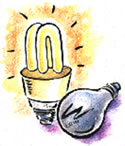 A person's interaction with his environment comes largely from visual cues. Without this information, a pedestrian can trip over an unseen object or a driver might not detect a dangerous situation. In order to avoid these hazards, a person requires adequate lighting and should be provided with appropriate illumination for a given task. Low light or sudden changes in light, such as glare, can disrupt vision and lead to an accident. Often the question arises as to whether a person could have, or should have, seen a particular object or event. Often, this can only be determined through detailed analysis and testing of the existing lighting conditions.
A person's interaction with his environment comes largely from visual cues. Without this information, a pedestrian can trip over an unseen object or a driver might not detect a dangerous situation. In order to avoid these hazards, a person requires adequate lighting and should be provided with appropriate illumination for a given task. Low light or sudden changes in light, such as glare, can disrupt vision and lead to an accident. Often the question arises as to whether a person could have, or should have, seen a particular object or event. Often, this can only be determined through detailed analysis and testing of the existing lighting conditions.
Expertise
We have extensive experience in many aspects of lighting and visibility including:
- Measuring lighting intensity
- Computer calculations for determining sun position for any given location, date, and time
- An extensive reference library on lighting standards and factors that determine if a hazard can be seen
Questions Answered
Through scientific analysis, we can help you answer pertinent questions such as:
- Was inadequate lighting a cause of the accident?
- What were the lighting conditions at a location on a certain date and time?
- Were lighting conditions sufficient for a given task?
- Did the sun's angle interfere with a driver's ability to see oncoming traffic?
Case Examples
Sunlight In Driver's Eyes:
A young girl drove her car into a stopped recycling truck, killing her schoolmate. Using the date and time of the incident, we computed the sun's angle at that time and locale. We then visited the site when the angle of the sun was comparable and photographed what could be seen by the driver. In this way, we showed how the driver was not criminally negligent and could not have seen the stopped truck until it was too late to stop.
Mall Outdoor Lighting:
A woman leaving a mall at night stumbled on the sidewalk curb as she was about to enter a waiting car. The plaintiff claimed that insufficient lighting was the only cause of her fall. We visited the mall at a time when the natural lighting conditions were very similar to the night in question and took several light meter measurements and photographs. These showed that the illumination of the sidewalk was sufficient to prevent a person from tripping on the curb and, thus, did not cause this accident.
Kristopher J. Seluga, PE, is a Mechanical Engineering, Accident Reconstruction, Biomechanics, and Safety Expert with over 20 years of experience. He received his Bachelor's and Master's degrees from the Mechanical Engineering department at MIT where he worked on the development of novel three-dimensional printing technologies. Mr. Seluga is also a licensed Professional Engineer in New York and Connecticut, and has served as a member of the ANSI engineering committee for the Z130.1 and Z135 standards for golf cars and PTV's. His research interests and peer reviewed publications span the topics of Motor Vehicle Dynamics, Product Safety, and Biomechanics.
©Copyright - All Rights Reserved
DO NOT REPRODUCE WITHOUT WRITTEN PERMISSION BY AUTHOR.



 A person's interaction with his environment comes largely from visual cues. Without this information, a pedestrian can trip over an unseen object or a driver might not detect a dangerous situation. In order to avoid these hazards, a person requires adequate lighting and should be provided with appropriate illumination for a given task. Low light or sudden changes in light, such as glare, can disrupt vision and lead to an accident. Often the question arises as to whether a person could have, or should have, seen a particular object or event. Often, this can only be determined through detailed analysis and testing of the existing lighting conditions.
A person's interaction with his environment comes largely from visual cues. Without this information, a pedestrian can trip over an unseen object or a driver might not detect a dangerous situation. In order to avoid these hazards, a person requires adequate lighting and should be provided with appropriate illumination for a given task. Low light or sudden changes in light, such as glare, can disrupt vision and lead to an accident. Often the question arises as to whether a person could have, or should have, seen a particular object or event. Often, this can only be determined through detailed analysis and testing of the existing lighting conditions.







